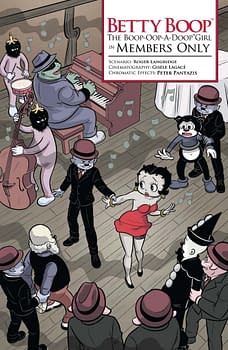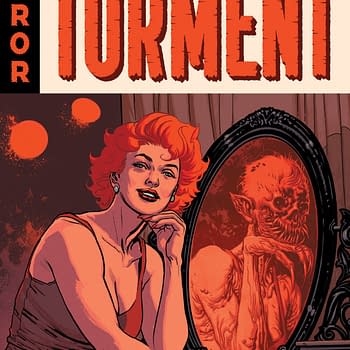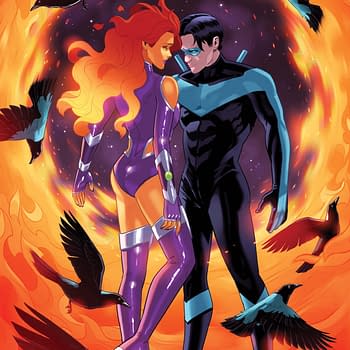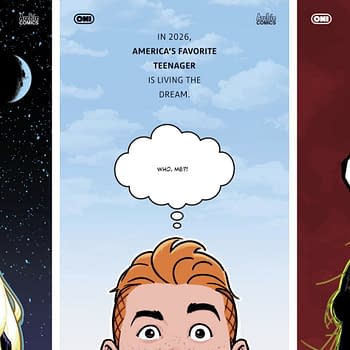Posted in: Comics | Tagged: betty boop, Comics, dynamite, entertainment, Gisèle Lagacé, roger langridge
"The 1920's Were A Decade Of Dramatic Change For Women" – Roger Langridge Talks Betty Boop
Fabrice Sapolsky, writer of Intertwined #2, talks with writer Roger Langridge about Betty Boop #2, both on sale now from Dynamite. Cover by Langridge and interiors by Gisele Lagace.

ROGER LANGRIDGE: Osmosis, mostly! I've been reading American comics and watching American cartoons and movies from the 1930s and 1940s since I was a child. They were never far away. The world is overwhelmed by American culture across all media; American entertainment was usually easier to find than anything created in my native New Zealand back in the 1970s. So elements of that culture inevitably became a part of my arsenal as a writer. With something like Betty Boop, of course, those 1930s American idioms I picked up from watching Bringing Up Baby and reading Thimble Theatre are cranked up to 11.
FS: In issue #2, Betty sings, "I'm nobody's gal but mine," which is at the same time very true to the character and very modern. You think Betty has always been this feminist icon, even before feminism as a political movement became prominent?
RL: I think that's a complicated question. The 1920s were a decade of dramatic change for women: after filling absentee men's jobs during World War 1, and getting the vote in 1920, the years between the wars held the promise that maybe, just maybe, women could do anything they set their minds to – and of course Betty Boop is very much a creation of those times. But she was created by men as their idea of a sexy girl, so that's there as well. Those two opposing forces are a tension inherent in the character. It's heartening, though, that the Fleischer's idea of a sexy girl was one who was tough and independent (although poor Olive Oyl, in the Fleischer Popeye cartoons, was constantly having to be rescued – unlike her take-no-guff comic-strip equivalent!).

RL: I don't do much of anything all day long that doesn't involve putting lines on paper one way or another, but I'm a huge fan of classic American newspaper strips like Thimble Theatre and Barney Google, which evoke that kind of Fleischeresque low-life atmosphere really well – to say nothing of old-time movies from Hollywood's golden era, featuring big-screen chancers and bums like W. C. Fields. And I love me a bit of Damon Runyon. It's all rattling around in my noggin waiting to come out.
FS: Writing a licensed character, there are some stuff you're allowed to do and some you're not. What's the biggest surprise you had, both good and bad, in that department?
RL: Betty Boop has been relatively smooth sailing in terms of what we've been allowed to do. There was a character I wanted to use who was off-limits at one point, but that's about it. I've done enough licensed material that I kind of know instinctively where the boundaries are – and know better than to take it personally if I'm asked to change things, because that's just the nature of the job – so I suppose that's my "good surprise": being largely left alone to get on with it!
FS: You're also an artist. How do you work with Gisele on the book? Do you draw thumbnails for every page or you let her do as she wants?

FS: When you write lyrics to the songs in the book, do you come up with the melody too? Do you sing over some existing songs? If so, which ones for that issue? I'd love to hear the real soundtrack of the Betty Boop comic !
RL: Ah, well, you see, it's a trick! Actual songs work differently from my written-down ones. You can use repetition more freely in a real song; you can fudge the meter if you want and let the melody take the slack. Whereas in a comic it has to work a bit more like a poem. The kind of lift and energy that normally would come from the tune is carried by the visuals – the way the characters move, whether the action is advancing during the song, even the color, all these elements affect the way you "hear" the song in your head. So there are no tunes, I'm afraid. That being said, if somebody wanted to set any of my ghastly doggerel to music, it might just be the best thing that ever happened to it!
For more information on Betty Boop #2, click here.














